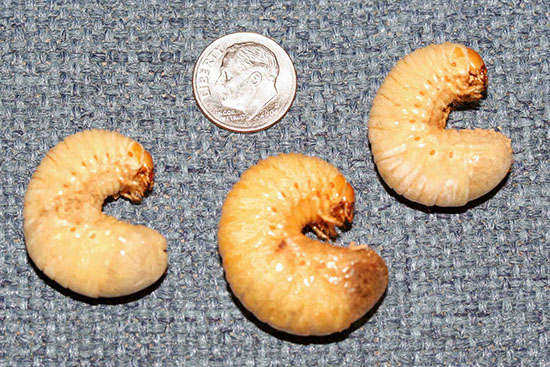Issue 17, October 19, 2016
Rotting Wood Borers
There are several species of beetles and other insects that tunnel through the rotting wood common in many trees. Generally, these are discovered when a tree blows over in a windstorm, gets hit by lightning, or is cut down. These insects are commonly inaccurately blamed for the tree going into decline or causing the tree to be weakened.
Xylem, which comprises the majority of the interior of tree trunks is dead tissue. Numerous wood rot fungi take advantage of this food source. Nancy Pataky wrote an article on wood rots in this newsletter in October 2008.
Hermit beetle, bessbug, and stag beetle larvae commonly take advantage of rotting wood, feeding on the wood rot fungi. They are generally unable to digest the wood itself, cellulose, but consume it to digest the fungi growing in it. These larvae are similar in appearance to the white grubs that attack turf roots, being white, elongate and thick-bodied with brown heads and three pairs of legs. They tend to be less C-shaped than white grubs and larger, commonly about two inches long when full grown.

Stag beetle larvae.
Adults of these insects are commonly found in the rotting wood as well as the larvae. They also come to lights at night. Hermit beetles are one inch long, brown scarab beetles with flat backs. They are chunky beetles, being almost as wide as long. Bessbugs are elongate black shiny beetles about one and one-half inches long with a hook-like horn on top of the head. Newly emerged adults are brown. Stag beetles are reddish-brown to dark brown beetles. Males are about one and one-half inches long with large jaws; they are commonly called "pinching bugs." Female stag beetles are about one and one-quarter inches long with shorter jaws than the males.

Stag beetle adult female.
Many mites and other insects are also associated with rotting wood including oribatid mites, other scavenging mites, predatory mites, springtails, psocids, flat bark beetles, darkling beetles, checkered beetles, rove beetles, and click beetles. Rotting wood supports an entire community of fungus feeders, scavengers, and predators using the wood rot fungi as the food base and the tree for shelter, but they are there secondarily. They arrived after the tree was in decline. (Phil Nixon)
Author:
Phil Nixon